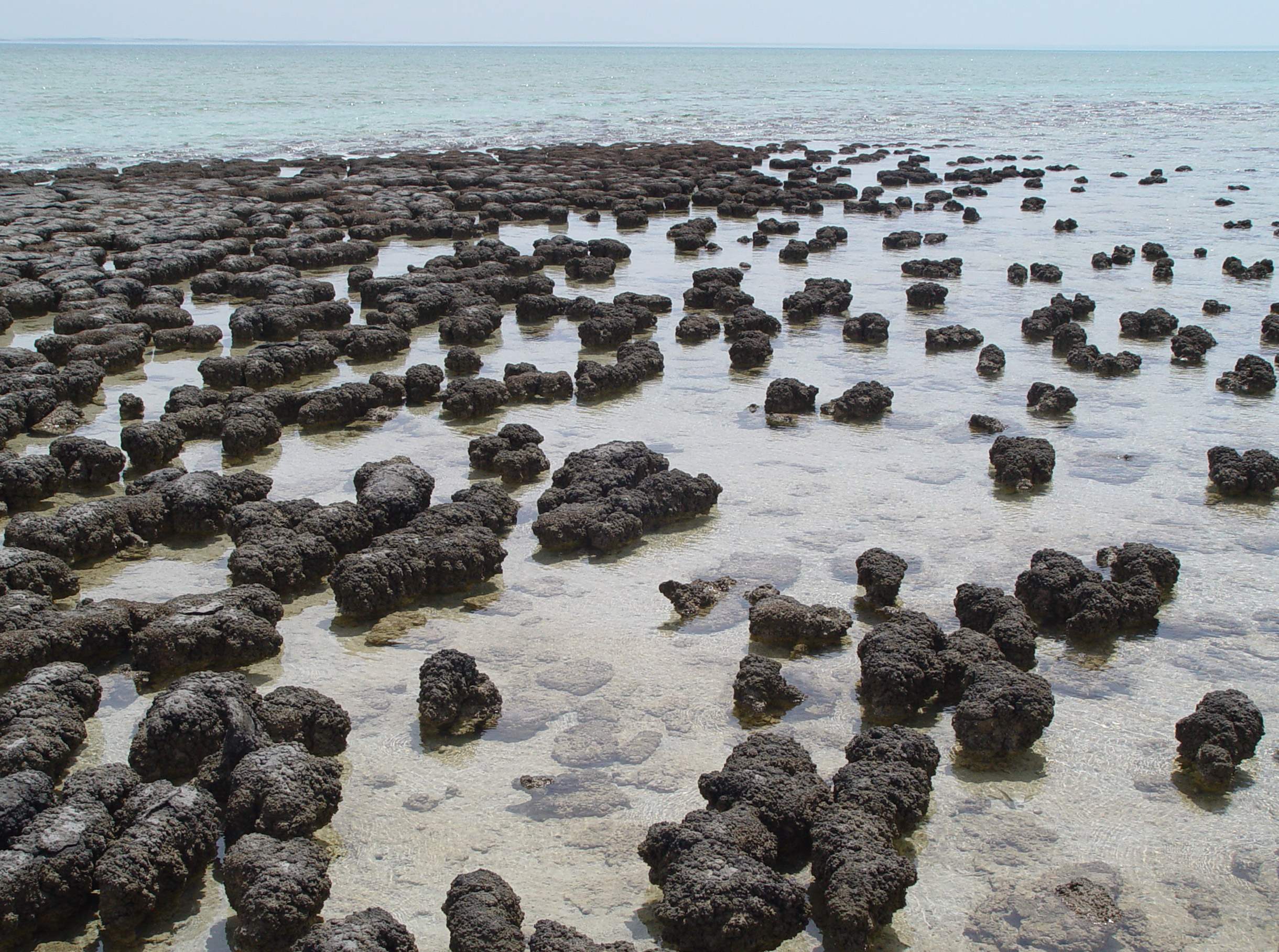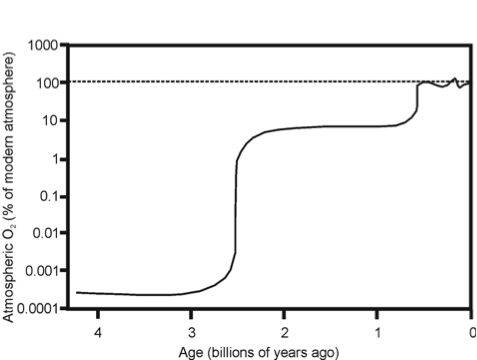Fossils of the Precambrian (4.6 BY to 542 MY)
The Precambrian Eon was initially identified in time-stratigraphy based on its apparent lack of fossils. We now know from isotopic evidence (chemical fossils) that life began at least as early as 3.8 billion years ago, and the earliest fossils date from around 3.5 billion years ago. Several locations around the planet had just the right conditions to preserve the soft-bodied animals living during the Precambrian, and paleontologists are still learning about early Precambrian life
Stromatolites: Kingdom Bacteria (Monera) (Before 3.5 BY? to Today)
Cyanobacteria (blue-green algae) are single celled prokaryotic Bacteria (the capital B specifically denotes Kingdom Bacteria – see Table 9.1 in the textbook) capable of photosynthesis. Cyanobacteria were the dominant form of photosynthetic organisms in the Precambrian and are believed to be largely responsible for increasing oxygen in the ancient atmosphere.
Early cyanobacteria were found in organo-sedimentary structures called stromatolites that formed in warm, intertidal environments. These structures started as layers of many cyanobacteria living side by side, covered with a mucus layer (Figure 6.3). Other types of Bacteria may also have been present in these mounds. Sediment particles became trapped in the cyanobacterial mat and the sticky mucus, and became incorporated into it. A layer of cyanobacteria then re-grew on top of the sediment particles, leading to a characteristic layered structure (laminations).

Stromatolites typically reached a size of up to 0.5 m across. The cyanobacteria found in stromatolites lived together in a group (though they were capable of living on their own), which means they had a colonial life habit. Stromatolites were far more common in the Precambrian than they are today, but you can still find them in some rare locations, such as Shark Bay in Australia (Figure 6.4).

A. Samples 121-30 & 121-29: Stromatolites
These samples may be picked up, but please treat them with care. Take a moment now and think about this: if you are holding one of these samples, you have the remains on one of the oldest living things on this planet in your hands. It is several BILLION years old.
Questions a & b
a. Find the layering within these fossils. What element combines with oxygen to make the reddish layers?
b. Are these fossils of colonial or solitary organisms? Explain your reasoning.
B. Sample F: Stromatolite
This sample may be picked up, but please treat it with care.
Question c
The First Eukaryotes (Early Proterozoic to 1.3 BY)
Eukaryotes are cells that contain a cell nucleus in which all the genetic material is found. They arose from large prokaryote cells that encompassed other smaller prokaryote cells and made the smaller cells into organelles in a process called endosymbiosis. The captured cells became mitochondria (which process energy) and plastids (which perform photosynthesis). These organelles carry their own DNA, which is part of the evidence that they used to be separate single celled organisms of their own. Preservation of single cells is rare, and deciding whether a fossil cell is eukaryotic and prokaryotic is difficult. The exact date of the emergence of eukaryotes is still under debate and has varied between editions of the textbook as new information comes to light.
Banded Iron Formations and the Rise in Oxygen (2.5 BY to 1.8 BY)
The early Earth had very little oxygen in its atmosphere: only 0.0002% of present atmospheric levels (Figure 6.6)!

Several lines of evidence indicate that atmospheric oxygen began to rise as early as 2.5 BY. The exact concentration of oxygen in the Proterozoic atmosphere is still being investigated, but the best estimate is that oxygen ranged from about 1% to 10% of current oxygen levels. This is one area of current research in which new discoveries are being made every year.
The early oceans contained large amounts of dissolved iron and silica produced by volcanoes at the mid-ocean ridges, but there was little oxygen in either the atmosphere or ocean. Starting around 2.5 BY, the increased production of oxygen in the shallow oceans by photosynthesizers such as cyanobacteria led to the deposition of silica and iron oxides in Banded Iron Formations (Figure 6.6).

Once all the iron and silica in the ocean were oxidized and locked into sediments, the oxygen that was being produced was able to add oxygen to the atmosphere. Terrestrial sediments that are that are red in colour from iron oxides did not become common until after 1.8 BY.
C. Samples SB6B & 121-BIF: Banded Iron Formation
These samples may be picked up, but please treat them with care.
Samples of 121-BIF have been polished and lacquered on one side to make the layering more visible. The layers in banded iron formations are composed of silica precipitated as chert of varying colours, and two types of iron oxides: haematite which is red, and magnetite which is a dark grey/black.
Question d
d. 2.5 BY ago, Earth had very little oxygen (in either the ocean or the atmosphere). What started to occur in the shallow ocean regions of Earth that allowed the iron and silica to precipitate to the ocean floor and form banded iron formations?
Multi-Celled Organisms (early Proterozoic to 900 MY)
The first organisms on Earth were all single-celled. Some of these may have come together to live as colonial organisms. Living in a colony can provide increased protection, or allow multiple individuals to create a common mineral skeleton which is more efficient than building one as an individual.
The next more complex form of organism is multi-celled, composed of cells that have specialized to different functions. The component cells are bound together, and any individual cell could not survive on its own. Multi-celled organisms today can be composed of as few as two cells.
Paleontologists have been unable to identify precisely the first multi-celled organism, but it was likely algae (plants). Since soft tissues are preserved only rarely, and the very first true multi-celled organisms would have only had soft tissues, they are unlikely to have been preserved in the fossil record. In addition, it is difficult to distinguish if a cluster of preserved cells are all the same and thus represent a colony, or if each cell is different and is part of a multi-celled organism. Dates as far back as 2.1 BY have been proposed for the first multi-celled organisms.
Multi-Celled Animals (900-700 MY)
It is difficult to distinguish multi-cellular plants of a just few cells from animals of a few cells. Fossils of worm-like macro-sized animals from China (dated to 700 MY) are currently accepted to be the earliest macro-sized animals (as opposed to microscopic scale). Trace fossils have been found at other locations where the actual worm is not preserved, but instead there is evidence of their burrows.
D. Samples SC11I: Worm Trace Fossils
This sample may be picked up, but please treat them with care.
Remember, soft-bodied organisms are only rarely preserved. Carbonization will sometimes preserve an outline. However, trace fossils can preserve their actions such as burrowing into sediments.
Questions e & f
e. This rock is shale, a horizontally layered sedimentary rock made up of fine clastic sediment. Noting this layering, how have the worm burrows been preserved? Hint: You may find it helpful to review Sample SC11GA from Lab 5.
f. What kingdom did the organism that made these trace fossils come from?
Modern-day percentage of a gas in the atmosphere. Abbreviated PAL.
A colony is a collection of individuals where any given individual cell is capable of surviving on its own, but survives better together.
